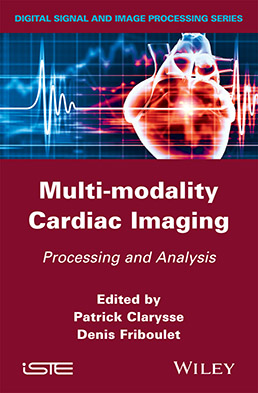
This book presents current and emerging methods developed for the processing and analysis of multi-modality cardiac images from state-of-the-art imaging systems, especially cardiac ultrasound imaging, magnetic resonance imaging (MRI) and X-ray computed tomography (CT). The availability of multi-dimensional images (2D, 2D+t, 3D, 3D+t, etc.) allows for the quantitative assessment of the heart's shape, tissues and function (contractility and perfusion, notably), and consequently the computer-aided assessment of cardiac pathologies.
Part 1 presents generic image processing concepts and methods, and their adaptation to multi-modality heart image analysis. It focuses on the extraction of contours/surfaces of the heart, on the quantification and analysis of the cardiac motion, on approaches to modeling and quantification of the cardiac perfusion, and on tensor decomposition of dynamic image sequences for contrast enhancement in myocardial perfusion studies and detection of contraction anomalies.
Part 2 starts by reviewing approaches for the quantitative evaluation of segmentation methods of cardiac structures in MRI. It then presents several applications in cardiac image analysis. Three phase-based methods are introduced and evaluated for the quantification of the cardiac motion in both echocardiography and MRI. The features of a free software tool for the integrated analysis of myocardial deformation from tagged MRI are described. Two matching-based methods for the estimation and study of the 3D kinetics of the left ventricular endocardial surface from dynamic X-ray CT are then presented and evaluated in the context of cardiac resynchronization therapy.
Part 3 concludes the book by presenting a methodology for the automatic personalization of a multi-physics heart model from multiple and heterogeneous clinical patient data. This kind of approach paves the way towards a computer-assisted patient-specific cardiology.
Part 1. Methodological Bases
1. Extraction and Segmentation of Structures in Image Sequences, Olivier Bernard, Patrick Clarysse, Thomas Dietenbeck, Denis Friboulet, Stéphanie Jehan-Besson and Jérome Pousin.
2. Motion Estimation and Analysis, Patrick Clarysse and Jérome Pousin.
3. Post-Processing and Analysis of Dynamic Magnetic Resonance Images for Myocardial Perfusion Quantification, Bruno Neyran and Magalie Viallon.
4. Tensor Decomposition of a Dynamic Sequence of Images into Simple Elements, Frédérique Frouin and Claire Pellot-Barakat.
Part 2. Application Examples
5. Evaluation of Cardiac Structure Segmentation in Cine Magnetic Resonance Imaging, Alain Lalande, Mireille Garreau and Frédérique Frouin.
6. Phase-based Heart Motion Estimation in Multimodality Cardiac Imaging, Martino Alessandrini, Adrian Basarab, Olivier Bernard and Philippe Delachartre.
7. Cardiac Motion Analysis in Tagged MRI, Patrick Clarysse and Pierre Croisille.
8. Left Ventricle Motion Estimation in Computed Tomography Imaging, Antoine Simon, Mireille Garreau, Régis Delaunay, Dominique Boulmier, Erwan Donal and Christophe Leclercq.
Part 3. Toward Patient-Specific Cardiology
9. Personalization of Electromechanical Models of the Cardiac Ventricular Function by Heterogeneous Clinical Data Assimilation, Stephanie Marchesseau, Maxime Sermesant, Florence Billet, Hervé Delingette and Nicholas Ayache.
Patrick Clarysse is Researcher for the French National Center for Scientific Research (CNRS) working at the CREATIS laboratory in Lyon, France. His research works focus on multi-dimensional medical image processing and modeling with primary applications in cardiovascular imaging.
Denis Friboulet is Professor at INSA-Lyon, France and works at the CREATIS laboratory in Lyon, France. His research interests include advanced signal and image processing with application to 2D/3D echocardiographic imaging.